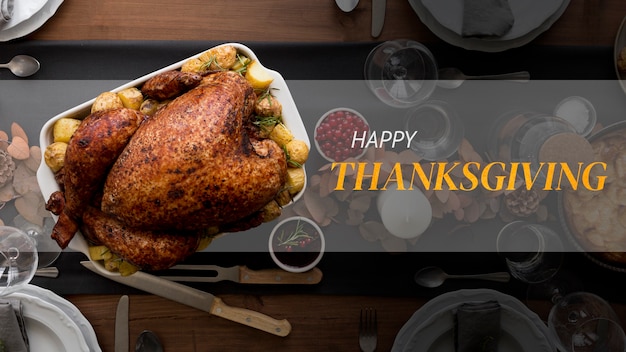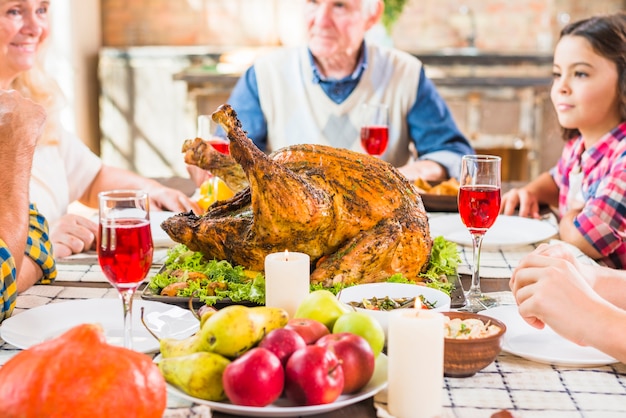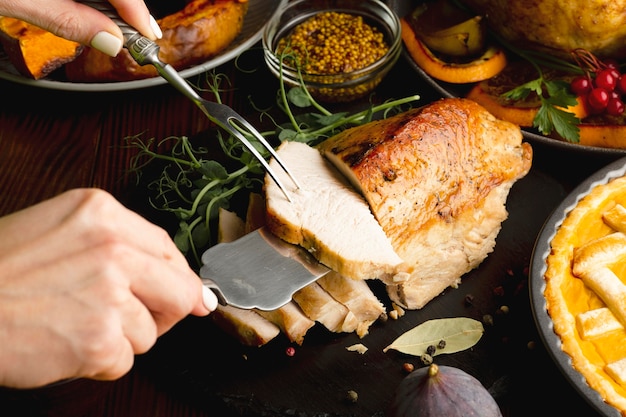Let's face it, there's nothing quite like the aroma of a roasted turkey wafting through the house. It's the centerpiece of countless festive gatherings, and getting it right is essential. But with so many different sizes and cooking methods, it can be tricky to figure out just how long to cook a turkey to achieve that perfect golden-brown exterior and juicy, succulent meat within.
I've been in the kitchen for years, battling countless turkeys, and I've learned a few tricks along the way. From my first attempts (let's just say, there were some dry bird incidents!), I've honed my skills and am here to share the secrets to a perfectly roasted turkey.
(Part 1)
The Big Bird: Getting to Know Your Turkey

Before you even think about turning on the oven, you need to understand the star of the show: the turkey.
Size Matters: Determining turkey weight
The weight of your turkey is the first clue to figuring out how long it needs to cook. A small turkey, around 4-6kg, is perfect for a cozy family dinner. But if you're hosting a grand feast, you'll need a larger bird, maybe 8-10kg. Knowing the weight helps determine cooking time and ensures everyone gets a generous helping.
Fresh or Frozen: Choosing the Right Bird
Now, the age-old question: fresh or frozen? For me, fresh turkeys, especially if you can snag one from a local butcher, are the way to go. The flavour is exceptional! But I understand the convenience of frozen turkeys. Just make sure you give it ample time to defrost – we're talking days, not hours. You want a fully thawed turkey, not a partially frozen one, to ensure even cooking.
The Art of Preparation: Getting Your Turkey Ready for the Oven

Once you've got your turkey, it's time to get your hands dirty. A little preparation goes a long way in ensuring a delicious and juicy bird.
Brining: A Secret to Tenderness
This is a game-changer. Brining, a simple technique of soaking the turkey in a saltwater solution, works wonders for the texture of the meat. It literally plumps up the turkey, making it unbelievably tender and juicy. It's like giving your turkey a spa day before the big event!
I find that an overnight brine, typically a mix of salt, sugar, and water, does the trick. But remember, don't over-brine. Too much salt can actually make the turkey taste bland.
Stuffing: The Controversial side dish
Ah, stuffing. The topic that sparks endless debates. Some swear by stuffing the turkey, while others argue for separate cooking.
My personal preference? I'm in the separate-cooking camp. It's safer, and it ensures the stuffing is cooked thoroughly. If you do choose to stuff your turkey, make sure it's not packed too tightly and cook it until the internal temperature reaches 165°F (74°C).
Seasoning: Adding Flavor to Your Turkey
Before that bird goes in the oven, let's spice things up! This is your chance to add your own personal touch. I love a simple blend of salt, pepper, and herbs like rosemary and thyme. You can also experiment with citrus zest, garlic powder, or even a bit of paprika for a smoky kick.
(Part 2)
The Big Bake: Cooking Your Turkey to Perfection

Now, the moment of truth – the roasting! Let's break down the cooking time and how to get a perfectly cooked turkey.
Determining Cooking Time: The Golden Rule
There's a general rule of thumb for turkey cooking time: about 20 minutes per pound (450g) at 350°F (175°C). However, it's more than just a simple calculation.
Using a meat thermometer: Your Secret Weapon
This is the most crucial tool for a perfectly cooked turkey. Don't rely on guesswork or visual cues alone. A meat thermometer is your safety net.
Resting: The Final Step for Juiciness
After the turkey emerges from the oven, resist the urge to carve it immediately. Let it rest, covered with foil, for at least 30 minutes. This allows the juices to redistribute, ensuring a more succulent bird.
Turkey Cooking Time: A Detailed Guide
Now, let's delve into the specific details you need to plan your feast.
Table of Turkey Cooking Times: A Quick Reference
This table gives you a general guideline for cooking time based on the weight of your turkey. Keep in mind, this is just a starting point, and you should always check the internal temperature with a meat thermometer to ensure the bird is cooked through.
| Turkey Weight (kg) | Cooking Time (hours) |
|---|---|
| 4-5kg | 2-2.5 hours |
| 6-7kg | 2.5-3 hours |
| 8-9kg | 3-3.5 hours |
| 10-11kg | 3.5-4 hours |
Factors Affecting Cooking Time: Beyond the Basics
While the table provides a good foundation, there are a few additional factors that can affect cooking time:
- Oven Temperature: A lower temperature will require a longer cooking time, while a higher temperature will speed things up.
- Stuffing: Stuffing absorbs heat, slowing down the cooking process. If you're stuffing your turkey, add extra time to the cooking time.
- Turkey's Shape: A large, broad turkey will take longer to cook than a smaller, thinner one.
Adjusting Cooking Time: A Common Sense Approach
The table is a guideline, not a strict rule. Here's a practical approach:
- Check the Temperature: The turkey is done when the thickest part of the thigh registers 165°F (74°C) on a meat thermometer.
- Start Checking Early: Don't wait until the end of the estimated cooking time to check the temperature. Start checking halfway through to ensure everything is on track.
- Cover with Foil: If the turkey is browning too quickly, cover it with foil to slow down the browning process and prevent it from drying out.
(Part 3)
Turkey Troubleshooting: Dealing with Common Issues
Even the most experienced cooks encounter a few hiccups in the kitchen. Let's tackle some common turkey issues.
Dry Turkey: How to Prevent and Fix It
A dry turkey is a cook's worst nightmare! Here's how to prevent and fix it:
- Don't Overcook: Overcooking is the biggest culprit. Use a meat thermometer to ensure the turkey is cooked through but not dried out.
- Brine: Brining helps lock in moisture and makes the turkey juicier.
- Basting: Basting with pan drippings or broth helps keep the turkey moist during cooking.
- Resting: Letting the turkey rest after cooking allows the juices to redistribute, resulting in a more succulent bird.
Undercooked Turkey: Ensuring Safety First
food safety is paramount. An undercooked turkey can pose a serious health risk.
- Use a Meat Thermometer: This is your most reliable tool for checking the turkey's internal temperature.
- Don't Guess: Even if the turkey looks cooked, don't rely on visual cues alone. Use a thermometer to be sure.
- Cook It Through: Make sure the thickest part of the thigh registers 165°F (74°C) on a meat thermometer.
Alternative Cooking Methods: Beyond the Traditional Oven
While the oven is a classic choice, there are other ways to cook a turkey that can yield delicious results.
slow cooker Turkey: A Hands-Off Approach
For a hands-off, slow and steady cooking method, a slow cooker is a great option. It's ideal for a moist and flavorful turkey without constant monitoring.
smoked turkey: A Smoky Twist
If you're looking for a unique smoky flavour, consider smoking your turkey. It's a bit more involved but produces a truly satisfying result.
turkey leftovers: Creating New Dishes from Your Feast
After the big feast, don't let those leftover turkey scraps go to waste! Here are a few ideas for delicious repurposing:
turkey soup: A Hearty and Comforting Dish
Nothing beats a warm bowl of turkey soup on a chilly day. It's a wonderful way to use up leftover turkey and vegetables.
turkey salad Sandwiches: A Light and Refreshing Option
For a lighter meal, make turkey salad sandwiches. It's a simple and satisfying way to enjoy leftover turkey.
FAQs: Answering Your Burning Questions about Turkey
Let's address some of the most common questions about turkey cooking.
Q1: Can I Cook a Frozen Turkey?
Yes, you can cook a frozen turkey, but it requires proper thawing. It's best to thaw it in the refrigerator, allowing ample time for it to defrost completely.
Q2: How Do I Stuff a Turkey?
If you choose to stuff your turkey, make sure the stuffing is cooked thoroughly. It's best to cook the stuffing separately to ensure safety.
Q3: How Long Should I Rest a Turkey After Cooking?
It's essential to rest the turkey for at least 30 minutes after cooking, covered with foil, to allow the juices to redistribute.
Q4: How Do I Know If My Turkey is Done?
Use a meat thermometer to check the internal temperature of the thickest part of the thigh. It should register 165°F (74°C).
Q5: What if My Turkey is Dry?
If your turkey is dry, try adding a bit of broth or pan drippings to help re-moisturize it. You can also carve it and serve it with gravy.
(Part 4)
Beyond the Bird: Completing Your Festive Feast
A turkey is just the beginning. Your festive feast deserves some delicious side dishes and desserts to complete the meal.
Side Dishes: Partnering the Turkey with Perfection
Here are some side dishes that pair beautifully with the turkey:
- Roasted Vegetables: Roasted vegetables like Brussels sprouts, carrots, and potatoes provide a delicious and colorful counterpoint to the turkey.
- Cranberry Sauce: A classic Thanksgiving or Christmas side, cranberry sauce adds a touch of tartness and sweetness to the meal.
- mashed potatoes: creamy mashed potatoes are a comforting and satisfying side dish that pairs perfectly with turkey.
Desserts: Ending Your Feast on a Sweet Note
No festive meal is complete without dessert. Here are a few ideas for ending your feast on a sweet note:
- Pumpkin Pie: A quintessential Thanksgiving dessert, pumpkin pie is a delicious and comforting way to end the meal.
- Apple Pie: Another classic pie, apple pie is a perfect balance of sweet and tart flavours.
- Chocolate Cake: For a decadent finish, a rich chocolate cake is a crowd-pleasing choice.
Conclusion: Your Ultimate Guide to Turkey Cooking
There you have it, my comprehensive guide to cooking a perfect turkey. From choosing the right bird to mastering cooking times and troubleshooting common issues, I've covered all the essentials.
Remember, cooking a turkey is more than just following a recipe. It's about understanding the bird, its size, and how to ensure it's cooked through and juicy.
With a little planning, practice, and a dash of confidence, you'll be serving up a delicious and impressive turkey that everyone will rave about. Happy cooking!
Everyone is watching

Corn on the Cob: The Ultimate Guide to Perfectly Cooked Ears
Healthy MealsAh, corn on the cob. Just the name evokes images of sunny days, barbecues, and that sweet, juicy flavour that ...

Perfect Pork Roast Oven Cooking Time: A Guide to Delicious Results
Healthy MealsThere's something truly satisfying about a perfectly roasted pork. The aroma alone is enough to make your mout...

Ham Cooking Time: How Long to Bake, Smoke, or Boil a Delicious Ham
Healthy MealsAh, ham. It's a classic, isn't it? A real crowd-pleaser, especially around holidays. And when done right, it'...

Scallops: The Ultimate Guide to Perfect Cooking
Healthy MealsAh, scallops. Those delicate, sweet, and utterly delicious morsels of the sea. They hold a special place in my...

Spaghetti Squash: The Ultimate Guide to Cooking and Serving
Healthy MealsRemember that time you saw spaghetti squash at the supermarket, looking all bumpy and strange, and thought, "W...
